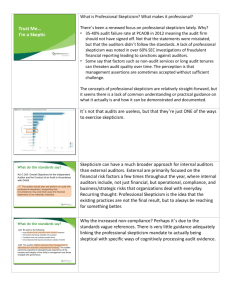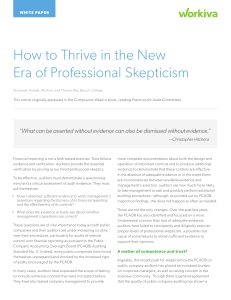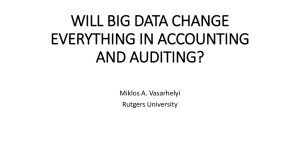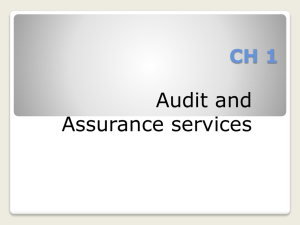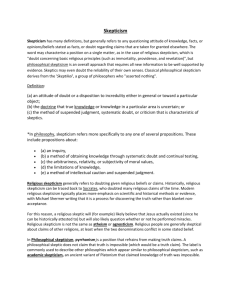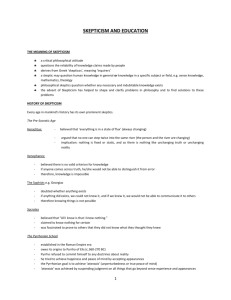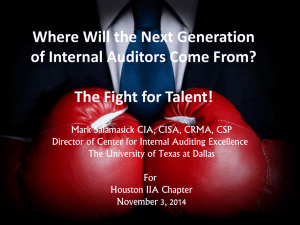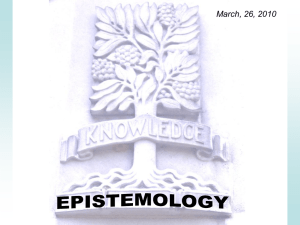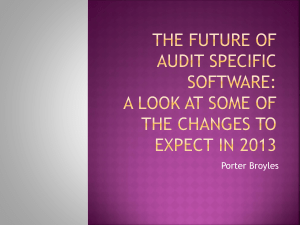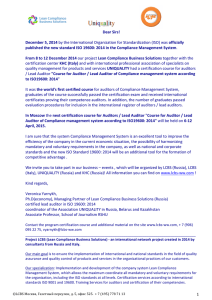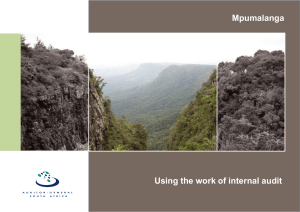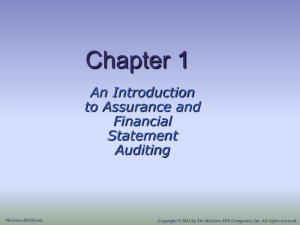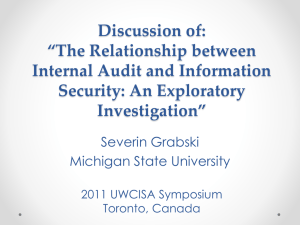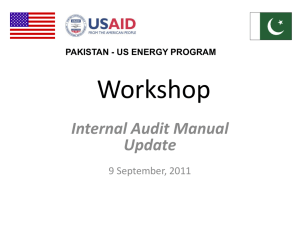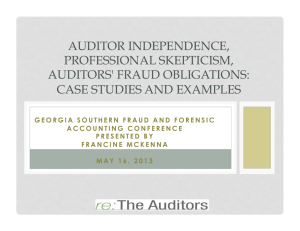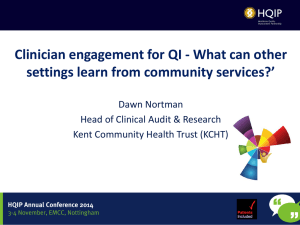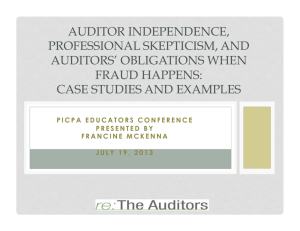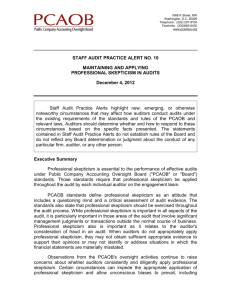Auditing: A Journal of Practice & Theory
advertisement
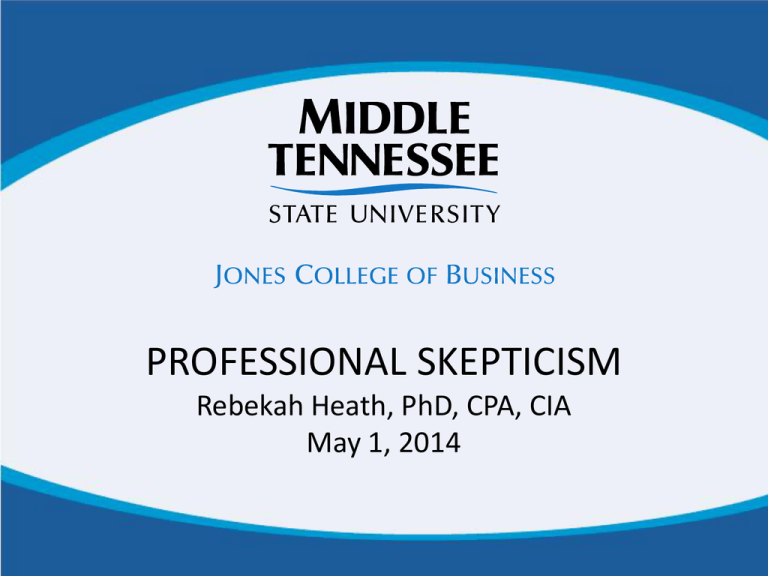
PROFESSIONAL SKEPTICISM Rebekah Heath, PhD, CPA, CIA May 1, 2014 Why the Continuing Interest? • Much has been discussed recently about the importance of PS as auditors are not perceived as consistently behaving skeptically or as varying substantially in their expression of skepticism (Hurtt et al., 2008). • PCAOB Staff Audit Practice Alert No. 10, Maintaining and Applying Professional Skepticism in Audits, was published on December 4, 2012. Staff Audit Practice Alert No. 10 • Certain circumstances can impede the appropriate application of PS and allow unconscious biases to prevail: – Incentives and pressures resulting from certain conditions inherent in the audit environment (i.e., to build/maintain a long-term audit engagement, avoid significant conflicts with management, keep audit costs low, and/or cross-sell other services) – Scheduling and workload demand (e.g., creates an incentive to seek audit evidence that is easier to obtain rather than evidence that is more relevant and reliable, to obtain less evidence than is necessary, or to give undue weight to confirming evidence) – Inappropriate level of confidence or trust in management. A PS Continuum • The definition we have been working is a “neutral” view of skepticism. – This viewpoint forms the basis of US public accounting standards. • Standards that focus on fraud suggest more of a forensic-auditing mindset in which auditors assume some level of dishonesty. The PS Continuum • Glover & Prawitt propose the use of a professional skepticism continuum that acknowledges that the appropriate application of PS will depend on the risk characteristics of the particular account and assertion being audited. A Regulator’s View • Nelson (2009) notes that “as a practical matter, auditors should note that regulators appear to take more of a ‘presumptive’ doubt perspective, as they typically refer to professional skepticism as something that was missing when an audit failure has occurred.” • However, taking such a perspective in auditing all assertions would result in the collection of MORE evidence than the other perspectives. Selected Research on PS: • Does PS change over time, and if yes, how does it change? (Ritter, Farmer, & Trompeter, 1987) – PS was very high when students left college. – Skepticism decreased over time as individuals moved from staff auditors to audit managers. – Partners exhibited approximately the same amount of PS as the students. • The authors hypothesize that those individuals who exhibited the higher levels of PS were more likely to become partner. Selected Research on PS: • Vitalis (2012) used an economics lab setting to investigate subject reaction to risk cues that emulated experience effects similar to that of auditors. – Student subjects received cue information that signaled a high or low risk situation. – Subjects could purchase additional cue information to help them maximize income over a period of time. – One pattern of cues was designed such that risk cues were available but subjects experienced a long series of results without a high-risk situation. Vitalis (2012) cont’d: • After some period of time (around 25 periods) a significant number of subjects no longer purchased risk information and thus were unable to identify that the series had changed to a highrisk situation. • This would be analogous to an auditor seeing a high risk situation and investigating it (often at different clients) over time and never finding a problem. That experience changes behavior! Vitalis (2012) cont’d: • Vitalis found that when he primed the subject that each period was a separate, unique event, the subjects remained more skeptical. • Thus, – Audit partners must keep teams focused and challenged on their conclusions at all times. – Auditors need to be trained to understand the uniqueness in every situation. – Developing an understanding of a client’s business and business strategy allows the auditor to understand the uniqueness of each company and argues against mandatory audit firm rotation. Is it possible to measure PS? • Hurtt (2007) has devised a systematic approach to assessing PS by using a 30-question instrument that consists of six separate characteristics of skeptics: – – – – – – Suspension of judgment Questioning mind Search for knowledge Interpersonal understanding Self-confidence Self-determination Training to Improve PS • Glover & Prawitt (2013) offer a few examples of approaches that have been shown to be effective in enhancing auditor PS: – Training in the application of various levels of PS across the continuum. – Training in proactive framing (i.e., reframing issues to see different perspectives) – Developing auditors’ cognitive skills linked to creative problem solving (e.g.,divergent and convergent thinking) Training to improve PJ as well as fundamental and specialized knowledge • Training specific to industry, operations, valuation methodologies, IT controls, and accounting so as to better identify risk • Training about the importance of setting independent expectations of unaudited account balances prior to focusing on the client’s recorded amounts. • Enhanced fraud training • Training in conflict resolution and difficult conversations References • Glover, S.M. and D.F. Prawitt. 2013. Enhancing Auditor Professional Skepticism. Electronic copy available at: http://www.thecaq.org/docs/research/skepticismreport.pdf • Hurtt, K., M. Eining and R.D. Plumlee. 2008. An Experimental Examination of Professional Skepticism. Electronic copy available at: http://ssrn.com/abstract=1140267 • Nelson, M.W. 2009. A Model and Literature Review of Professional Skepticism in Auditing. Auditing: A Journal of Practice & Theory, 28 (2): 1-34. • Ritter, L.E., T. Farmer and G. Trompeter. 1987. An Investigation of the Impact of Economic and Organizational Factors on Auditor Independence. Auditing: A Journal of Practice & Theory, Fall: 1-14. • Vitalis, A. 2012. Experimental Tests of Experience and Costly Risk Cues on Risk Assessment Decisions, unpublished working paper. Questions/Comments?
